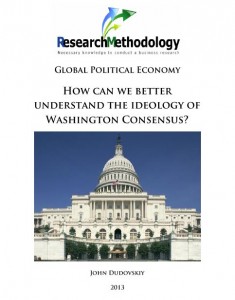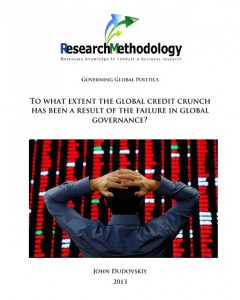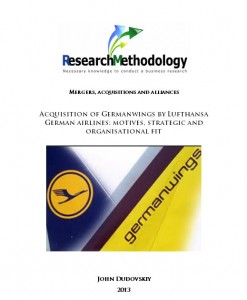
This paper critically analyses the ideology of Washington Consensus. The paper starts with discussions about factors and circumstances that have caused the emergence of Washington Consensus. This is followed by discussing positive implications of Washington Consensus for certain countries by referring to relevant facts. Moreover, the paper highlights major points of criticism of Washington Consensus and the attempts to assess the level of their validity of these points and discusses reasons and circumstances for introduction of Post-Washington Consensus also known as Washington Consensus II. The paper is completed by attempting to the future of Washington Consensus prescriptions in modern dynamic global geo-political environment. There always have been disparities between countries in terms of the levels of economic developments and this tendency is most likely to continue in the future. However, there have been attempts by highly developed countries to assist the level of economic development of developing countries through various programs involving financial aids and recommendations. A set of policy recommendations proposed by the US to developing countries has been known as Washington Consensus, and there are mixed opinions about the implementation and outcome of these recommendations (Bandelj and Sowers, 2010). Introduction 1 Emergence of Washington Consensus 1 Potential Positive Implications of Washington Consensus 4 Criticism of Washington Consensus and the Level of their Validity 6 Washington Consensus II and the Level of its Effectiveness 10 The Future of Washington Consensus 11 Conclusions 14 References 16 International Monetary Fund World Trade Organisation World Bank How do I receive the report? Once payment is made you will receive a link to you e-mail you have registered with on Pay Pal or the e-email you have entered when specifying bank details to download the report. The report is downloaded in PDF format. The link will stay active for 7 days. How can…

Unilever is a global consumer products manufacturer that achieved EURO 50 billion turnover with over 173,000 employees in 2012 and its portfolio includes such famous brand names as Dove, Magnum, Knorr, PG, Hellmann’s and others (Annual Report and Accounts, 2012). Unilever specifies its purpose as ‘to make sustainable living commonplace’ Unilever has formulated its vision as “double the size of the business, whilst reducing our environmental footprint and increasing our positive social impact”. The mission statement of the company has been worded as “meeting the everyday needs of people everywhere”. Unilever Organisational Stakeholders and their Objectives The following table represents Unilever organisational stakeholders and their objectives Stakeholders Objectives (expectations) Achievement of objectives Internal stakeholders Employees Adequate compensation and working environment Effective organisational culture More than EURO 5,1 billion 173,000 paid to employees in 2013 A set of effective employee social protection programs Managers Career growth opportunities Challenging working atmosphere Unilever Facebook global careers page attracted 110,000 ‘likes’ within 6 month of launch Owners Long-term growth of the company Consistent profitability growth for numbers of years External stakeholders Government Adherence of the company to rules and regulations Payment of appropriate amount of taxes in a timely manner Unilever criticised for basing 26% of its subsidiaries in ‘tax heaven’ countries such as Costa Rica, Philippines, Guatemala, and Hong Kong (Ethical Consumer, 2012) Suppliers Long-term partnership in a mutually beneficial manner Unilever possesses Fairtrade Certification for the majority of its products Society High levels of corporate social responsibilities Development of Unilever Sustainable Living Plan Commitment to reduce greenhouse gases by 50% by 2020 Development of Sustain Ability Challenge Creditors Effective management team Adequate level of equity Consistent rise of profitability for a number of years Increasing brand value Shareholders Long-term growth of the company The full year dividend in 2012 increased to…

This paper critically analyses the extent at which a failure in global governance contributed to the recent global credit crunch. The paper starts with discussing the primary reasons of the credit crunch of 2007-2009, and its implications on the global economy. This is followed by analysis of the current state of global governance, and its impact on credit crunch. Moreover, the paper highlights potentials for avoiding credit crunch in the future through improving global governance practices. The global economic and financial crisis of 2007 – 2009 has shed a light in inefficiencies of the international financial system and the current pattern of the global governance. The current system of global financial governance has found to be mainly insufficient to predict and contains financial instability. The need for efficient global governance needs a shift to an improved balance between the two worlds of financial globalization i.e. private financial activity and public financial governance (Porter, 2009). The credit crunch reveals great challenges and threats to the developed economies as well as developing states. The global banking industry, which was by far the most profitable sector in 2006, is in much trouble and the risk that this poses to the real economy is thoughtful (Wade, 2008). The global financial crisis of 2007-triggered by the sub-prime mortgage crisis in the spring previously led to a significant decrease in production in autumn 2008, which has continued in 2009 and went on to produce the spring of 2009 to the present day effects, both social (rising unemployment decrease in disposable income, declining demand, social problems) and political (government changes, erosion of confidence citizens in the performance of governments and the political class), and thus increased the difficulties of public finances in developed countries causing in 2010 a series of crises (Nesvetailova, 2010). 1. Introduction 1 2.…

There is set of factors that effect team functioning. These factors include, but not limited to the nature of group norms, the level of cohesiveness, team leadership, rewards and others. Group norms resemble a code of conduct that specifies the extent of acceptable behaviour within the groups. As an important factor impacting team functioning, group norms need to be formulated in a clear and straightforward manner. Moreover, group members need to be communicated about penalties for deviating form group norms. Group cohesiveness can be explained as the level of attractiveness of the group to its members and is a major factor impacting group functioning. Managers need to be focusing on increasing the levels of cohesiveness through associating being group members with personal and professional growth, as well as, a range of tangible benefits. Moreover, leadership plays substantial role on the effectiveness of team functioning. Team leaders need to be able to command respect from team members and they need to be emotionally intelligent as well. Importantly, team leaders need to be able motivate each member of team in personal levels. Rewards associated with team performance can be listed as another important factor impacting team functioning. Rewards to team members need to comprise tangible elements such as financial compensation and various perks, as well as, intangible elements such as celebration of achievement, recognition of contribution of each individual team member in formal and informal ways. Failure to achieve the positive impact of the factors listed above may cause the formation of dysfunctional teams that are not well positioned to achieve organisational aims and objectives.

Group has been defined as “an avenue through which group members experience mutual benefit” (Horn, 2011, p.214) and groups can be formal or informal. Teams can be specified as a specific form of group that aim to solve long-term problems and teams have a greater level of commitment to achieve common goals compared to groups. Therefore, it is important for managers to be transforming workforce groups into teams. Belbin’s Team Roles Theory specifies a set of different roles to be present in successful teams as plants, resource investigators, co-ordinators, shapers, monitors/evaluators, team workers, implementers, completer/finishers and specialists. Group behaviour can have positive, as well as, negative implications on the achievement of organisational goals. Positive implications of group behaviour on the achievement of organisational aims and objectives can be achieved through associating group identity with the achievement of those aims and objectives. In simple terms, in order to generate desirable group behaviour team loyalty to the achievement of organisational goals need to be increased through promoting relevant shared beliefs and improving overall organisational culture. Group behaviour can also have negative implications on a wide range of organisational processes. This can be expressed through resistance to change, lack of commitment to organisational aims and objectives and a range of other ways. It is critically important for organisational managers to adopt a proactive approach in terms of impacting group behaviour with positive implications on the achievement of organisational aims and objectives. References Horn, T. (2011) “Advances in Sport Psychology” Human Kinetics

Mergers, acquisitions and formation of alliances are commonplace in global airline industry and they are fuelled by the search of competitive advantages in order to achieve long-term growth. However, the implementation of mergers, acquisitions and formation of strategic alliances in practice can be associated with a set of complex challenges that might include differences in organisational culture, clash of personalities within top level management, lack or absence of strategic fit between the two companies and others. Lufthansa Group is a global airline company that employs more than 120,000 workforces that have contributed to generate 713 million EURO through serving 100.6 million passengers during the year of 2011 alone (Annual Report, 2011). Germanwings is a budget airline company that employs 1355 members of staff and served 7.52 million customers in 2011 offering flights to more than 90 destinations with 33 Airbus A 319 airplanes (Facts and Figures, 2013, online). Germanwings is wholly owned by Lufthansa since 2009. This report investigates a range of business issues related to the acquisition of the budget airline Germanwings by Lufthansa German Airlines in 2009. The report starts with analysis of motives for choosing acquisition method among other alternatives by Lufthansa. This is followed by discussions of strategic and organisational fit between Lufthansa and Germanwings. Moreover, this report addresses potential gains and risks faced by Lufthansa due to the acquisition of Germanwings. The report is concluded with assessing outcomes relative to expectations in relation to this specific airline acquisition. 1. Introduction 1 2. The Motives for Choosing Acquisition Method by Lufthansa 2 2.1 Short Time Required to Complete the Acquisition 2 2.2 Willingness to Increase the Market Share 3 2.3 Overcoming Entry Barrier in Budget Airline Sector 4 2.4 Easiness of Integration 4 3. The Strategic and Organisational Fit between Lufthansa and Germanwings 5 4. The…

Leadership styles exercised in two global companies – Microsoft, a global software corporation based in Washington and Apple, consumer electronics and software manufacturer headquartered in California can be compared in detailed manner. Microsoft can be mentioned as one of the stark case studies, where democratic leadership style of its founder and former CEO, Bill Gates contributed to the global success of the company making Bill Gates the richest person in the world for several years. There was a little or no change in leadership style when Steve Ballmer took over as CEO in 2000, with employees being involved in strategic decision making. On the contrary, there is a consensus amongst business researchers that late Apple CEO Steve Jobs exercised autocratic leadership style with lack of concern for employee engagement in strategic decision making (Isaakson, 2011). Moreover, Steve Jobs famously dismissed marketing research as a waste of time, stating that customers did not know what they wanted, and this fact further emphasises his autocratic leadership style. According to Steve Jobs, rather than spending large sums of money on marketing research and involving employees to discuss research findings, organisational leaders need to be engaged in developing innovative products and add innovative features in existing products that people would like to purchase (Isaakson, 2011). It is important to note that despite large differences between Microsoft and Apple leadership styles as discussed above, both organisations have been able to be highly successful in global scale. Accordingly, rigid generalisations about effective and ineffective leadership styles needed to be avoided. In other words, each individual leadership style can be effective or ineffective depending on a wide range of factors such as personality, skills and competencies of the leader, organisational culture, specifications of the industry, level of education of employees etc. Amazon.com Inc. Report contains the application…

There are set of factors that impact employee behaviour in direct and indirect ways. These factors can be internal to organisation such as work culture, leadership, job responsibilities relationships with colleagues etc., or external such as the extent of work-life balance, changes in personal circumstances, employee cultural background, the extent of interpersonal skills etc. Work culture can be defined as “applying the general characteristics of culture to the specifics of how people work at a point of time and place” (Moran et al., 2007, p. 30) and work culture is one of the major factors impacting employee behaviour. Work culture is usually set by founder(s) of organisation, but it can change over a course of time. In simple terms, in order to survive employees have to fit in the current work culture. The quality of organisational leadership has also great impact on employee behaviour in a way that effective organisational leaders can inspire and motivate employees for greater performance, at the same time when ineffective leaders can cause employee knowledge, skills and competencies not being fully utilised. Employee job responsibilities can be mentioned as important factor impacting employee behaviour because extensive range of roles and responsibilities can cause burnout for employees with all the negative consequences. In personal level, the extent of work-life balance of employees has direct and significant implications on their behaviour. Specifically, lack of work-life balance is most likely to have negative implications on employee behaviour and performance in various levels. Similarly, employee-specific factors such as cultural background and interpersonal skills and competencies greatly affect employee behaviours. Therefore, managers need to take into account these differences when dealing with each individual employee. References Moran, R.T., Harris, P.R. & Moran S.V. (2007) “Managing Cultural Differences: Global Leadership Strategies for the 21st Century” 7th edition, Routledge

Generally, organisational structures are divided into three types: functional, divisional and matrix. Functional organisational structure is associated with dividing organisation into different departments such as IT, finance, marketing according to their functions. Divisional organisational structure, on the other hand, relate to organisations where divisions are formed on the basis of geographical locations or product lines. In this type of organisational structure each division possesses its own departments such as IT, finance, marketing and others. Matrix organisational structure comprises elements of functional and project-based organisations. Employees in this type of organisations report to two bosses – project leaders and heads of functional departments.

Literature review has identified a set of factors that are able to trigger cultural changes. These factors causing cultural change have been found as leadership change, technological developments, mergers and acquisitions and others. Discussions of each of these factors in greater details are provided below. 1. Leadership Change Authors such as Beer (2012), Christopher (2012) and Morgan (2012) agree that changes in top level management can result in changes in organisational culture. According to Beer (2012), initially, organisational culture is set by the founder of the organisation, but the initial culture set by founders might be subjected to changes due to the impact of a wide range of factors. At the same time, Beer (2012) acknowledges that this argument relates to private sector organisations at a greater extent compared to public sector organisations. Nevertheless, Beer (2012) and Christopher (2012) argue that change at organisational leadership causes changes to organisational culture to a certain extent. Christopher (2012) further reasons that the extent to which organisational culture is subjected to change to due to change in leadership depends on a set of factors such as the difference between the new and old strategy to achieve organisational objectives, personal traits and characteristics of a new leader etc. 2. Technological Developments The extent of technological developments that have especially accelerated during the last two decades have been found as a major factor causing cultural changes by Maude (2011) and Davel et al. (2013). Maude (2011) mentions the instances of using mobile phones in public to illustrate the impact of this factor. Specifically, according to Maude (2011) while it was perceived to be a rather rude behaviour to engage in lengthy conversations in mobile phones in public places such as public transport only twenty years ago, nowadays such behaviour is generally perceived…
By John Dudovskiy
Category: Change
